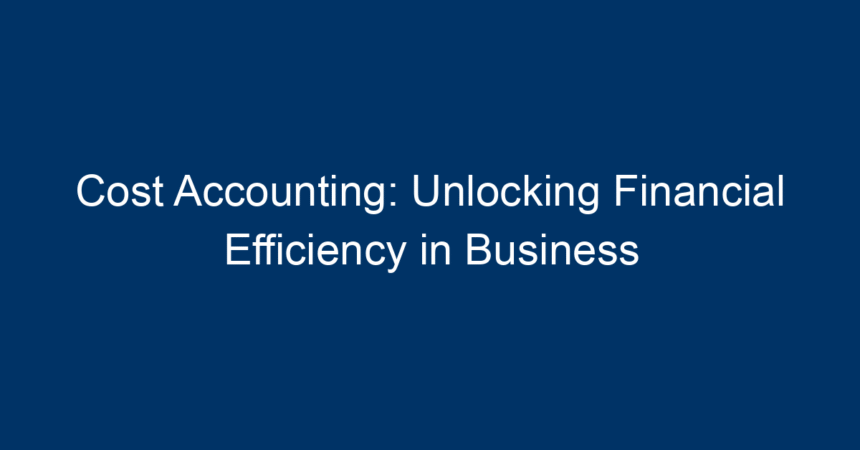In today’s competitive marketplace, understanding the financial nuances of a business is crucial for sustainable growth. Enter cost accounting, a powerful financial management tool that transcends mere bookkeeping to unlock the mysteries of profit maximization and efficiency. This article delves into the essentials of cost accounting, helping business owners, managers, and finance enthusiasts alike comprehend its transformative potential.
What is Cost Accounting?
Cost accounting refers to the process of capturing, analyzing, and regulating costs associated with the production of a good or service. Unlike financial accounting, which provides a snapshot of a company’s overall financial health, cost accounting focuses on the internal operations, allowing businesses to make informed financial decisions.
Key Objectives of Cost Accounting
- Cost Control: By understanding the costs involved in production, businesses can identify areas for reducing expenditures.
- Cost Allocation: Cost accounting helps in attributing costs accurately to different departments or products, ensuring transparency.
- Performance Evaluation: Through variance analysis and other methodologies, companies can evaluate how well they are adhering to the budget.
The Importance of Cost Accounting
Cost accounting serves as a foundation for strategic decision-making and operational efficiency. Here we explore its multifaceted importance:
1. Enhances Financial Insights
Cost accounting offers granular insights into operational costs, enabling businesses to detect inefficiencies. By analyzing these costs, managers can devise strategies to optimize resource allocation, reducing waste and increasing profitability.
2. Supports Budgeting and Forecasting
Accurate costing serves as a vital component in the budgeting process. Understanding historical costs helps in forecasting future expenditures, facilitating more reliable and effective budget preparations.
3. Informs Pricing Strategies
Understanding the cost structure is essential for setting competitive yet profitable prices. With accurate cost accounting, businesses can ensure that their pricing strategy protects their margins while appealing to customers.
4. Encourages Accountability
Cost accounting fosters a culture of accountability within organizations. When departments are aware of their costs, they are more likely to take responsibility for managing budgets and achieving financial targets.
Key Components of Cost Accounting
Cost accounting involves several methodologies and components that provide a comprehensive overview of cost management. Let’s delve deeper into these essential elements:
1. Types of Costs
- Fixed Costs: Costs that do not change with the volume of production, such as rent and salaries.
- Variable Costs: Costs that fluctuate with production volume, like raw materials.
- Semi-Variable Costs: Costs that have both fixed and variable components, such as utility bills.
2. Costing Methods
Different costing methods can be employed depending on the industry and objectives. Here we outline a few common methods:
- Job Order Costing: Used for unique or custom orders, this method accumulates costs for specific jobs to determine profitability.
- Process Costing: Ideal for mass production, process costing averages costs over units produced, simplifying pricing decisions.
- Activity-Based Costing (ABC): This sophisticated method assigns costs based on actual activities, enhancing accuracy in cost allocation.
3. Variance Analysis
Variance analysis is pivotal in cost accounting, comparing actual costs to budgeted costs to identify discrepancies. Regularly conducting variance analysis enables businesses to take corrective measures promptly, ensuring better financial performance.
Implementing Cost Accounting in Your Business
Successfully integrating cost accounting into your business involves several steps. Here’s a guide to help you get started:
Step 1: Assess Your Needs
Determine what financial insights your business requires. Are you looking to reduce waste, optimize pricing, or evaluate performance? Establishing clear objectives will guide your cost accounting efforts.
Step 2: Choose the Right Methodology
Select a costing method that aligns with your business model. Consider factors such as the nature of production, volume, and product diversity.
Step 3: Invest in Training
Ensure that your finance team is well-versed in cost accounting principles. Consider workshops or online courses that focus on the latest cost accounting techniques.
Step 4: Use Technology
Implement cost accounting software to automate data collection and reporting. Advanced tools can facilitate real-time analysis, allowing for quicker decision-making.
Step 5: Regular Review and Adjustment
Cost accounting is not a one-time endeavor. Regularly review your costs and accounting processes to adapt to changing business conditions and maintain financial efficiency.
Case Study: A Real-World Example
To illustrate the effectiveness of cost accounting, let’s take a closer look at a fictional manufacturing company, WidgetCo. Faced with declining profits, WidgetCo implemented an ABC costing system to analyze its production costs more effectively.
Results
- Increased Efficiency: By understanding which products consumed the most resources, WidgetCo optimized its manufacturing processes.
- Improved Pricing Strategy: Armed with detailed cost data, the company adjusted its pricing strategy, leading to improved profit margins.
- Better Budgeting: The enhanced cost visibility allowed WidgetCo to create more accurate budgets, reducing overspending by 20%.
Common Challenges in Cost Accounting
While cost accounting is immensely beneficial, it does come with its challenges:
1. Complexity of Data
Managing vast amounts of data can be daunting. Businesses must prioritize accurate data entry and regular updates to maintain effective cost accounting practices.
2. Resistance to Change
Implementing a new cost accounting system may face resistance from employees accustomed to traditional methods. Effective change management strategies are essential for smooth transitions.
3. Continuous Training
As cost accounting evolves, ongoing training is necessary to keep staff updated on best practices and new technologies.
Conclusion: Unlocking Financial Efficiency
Cost accounting is more than just a financial measurement tool; it’s a pathway to unlocking enhanced operational efficiency and driving business growth. By understanding costs at a granular level, companies can make data-driven decisions that enhance competitiveness.
Actionable Insights:
- Begin by assessing your current cost structure.
- Choose an appropriate costing method that suits your business model.
- Invest in training and technology for seamless implementation.
- Conduct regular reviews to adapt to market changes.
Embrace cost accounting today to ensure your business thrives in a financially efficient landscape. By taking these actionable steps, you will not only improve profitability but also establish a foundation for sustainable growth.




